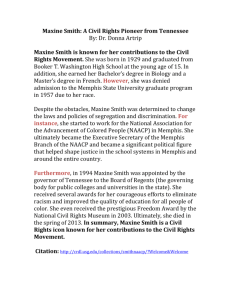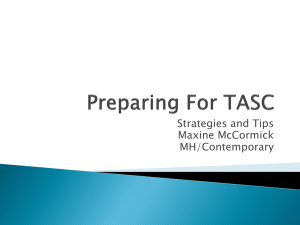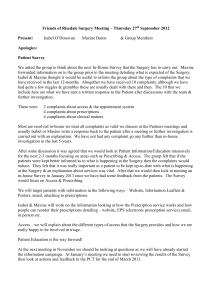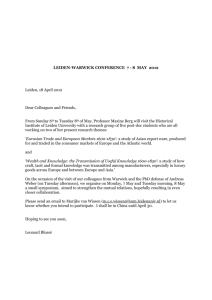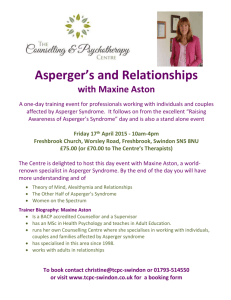Jerome Groopman, “Dying Words.” The New Yorker, October 28, 2002.
advertisement
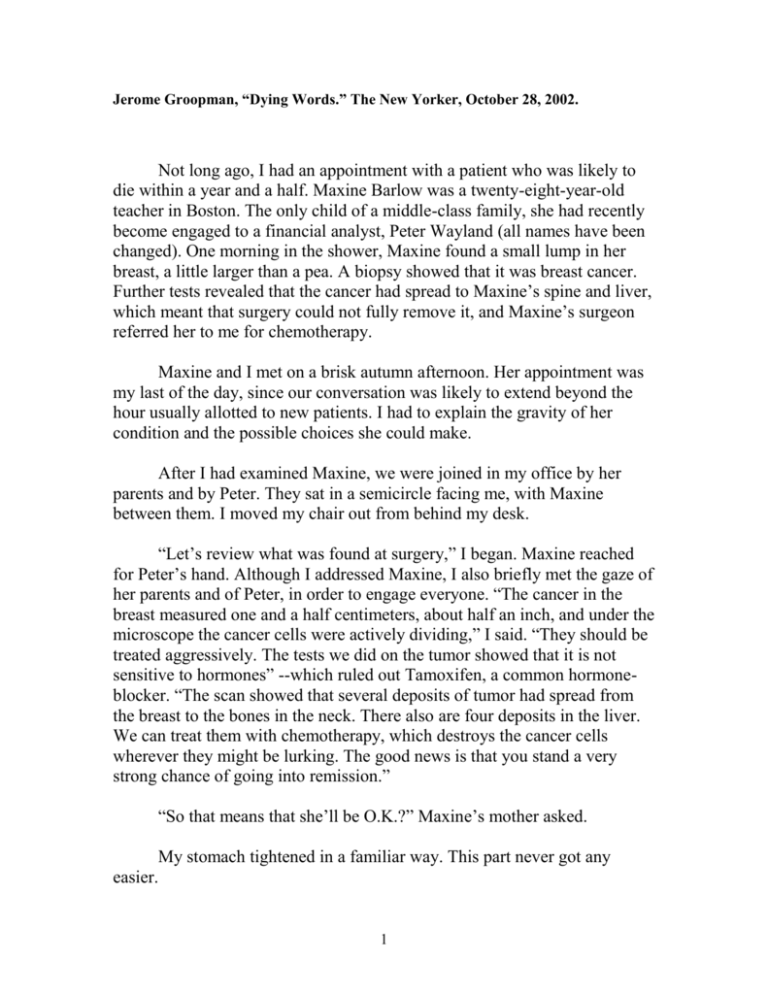
Jerome Groopman, “Dying Words.” The New Yorker, October 28, 2002. Not long ago, I had an appointment with a patient who was likely to die within a year and a half. Maxine Barlow was a twenty-eight-year-old teacher in Boston. The only child of a middle-class family, she had recently become engaged to a financial analyst, Peter Wayland (all names have been changed). One morning in the shower, Maxine found a small lump in her breast, a little larger than a pea. A biopsy showed that it was breast cancer. Further tests revealed that the cancer had spread to Maxine’s spine and liver, which meant that surgery could not fully remove it, and Maxine’s surgeon referred her to me for chemotherapy. Maxine and I met on a brisk autumn afternoon. Her appointment was my last of the day, since our conversation was likely to extend beyond the hour usually allotted to new patients. I had to explain the gravity of her condition and the possible choices she could make. After I had examined Maxine, we were joined in my office by her parents and by Peter. They sat in a semicircle facing me, with Maxine between them. I moved my chair out from behind my desk. “Let’s review what was found at surgery,” I began. Maxine reached for Peter’s hand. Although I addressed Maxine, I also briefly met the gaze of her parents and of Peter, in order to engage everyone. “The cancer in the breast measured one and a half centimeters, about half an inch, and under the microscope the cancer cells were actively dividing,” I said. “They should be treated aggressively. The tests we did on the tumor showed that it is not sensitive to hormones” --which ruled out Tamoxifen, a common hormoneblocker. “The scan showed that several deposits of tumor had spread from the breast to the bones in the neck. There also are four deposits in the liver. We can treat them with chemotherapy, which destroys the cancer cells wherever they might be lurking. The good news is that you stand a very strong chance of going into remission.” “So that means that she’ll be O.K.?” Maxine’s mother asked. My stomach tightened in a familiar way. This part never got any easier. 1 “Remission does not mean cure,” I said. “Remission means that all the cancer we can measure disappears. Therapy is palliative.” “What do you mean, ‘palliative’?” Peter asked in a panicked voice. “She has to be cured,” Maxine’s father said. This distinction was important, and I needed to make sure, gently but unequivocally, that they understood. “There is a very good chance that we will see the metastatic deposits in your bones and liver shrink significantly, or completely melt away. But the most intensive chemotherapy or radiation available -- even bone-marrow transplant -- is not enough to destroy every cancer cell in your body. That is why, currently, we cannot say the cancer can be cured.” Maxine sat without speaking. Her eyes filled with tears, and I gave her some tissues. “What is the point of treatment, then?” I asked. “Palliation. That means that even if the cancer cannot be cured it can be controlled. The bestcase scenario is that the cancer becomes like a parasite,” I said, purposefully invoking a stark image. “We knock it down with the therapy, and hope that it stays down for many, many months or years. You can live an active life -work, jog, travel, whatever. The bones and liver can heal. And when the cancer returns we work to knock it down again. All the while, we hold on to the hope that an experimental treatment will be found that is able to eradicate the cancer -- to truly cure you.” Like Maxine, Mrs. Barlow was fighting back tears. Her husband stared at me. I paused before broaching a second critical issue. “We talked about the best-case scenario. But we also have to acknowledge that there is a worst-case scenario.” I had found that this part of the discussion was best completed rapidly, as if removing an adhesive bandage. “The worst-case scenario is that ultimately the cancer becomes resistant to all the treatments we have, and even experimental therapies are no use. Most people say that if they reach a point in the illness when their 2 brain is impaired, and there is no likelihood of improving their quality of life, then nothing should be done to keep them artificially alive, through machines like respirators. It’s essential, Maxine, that I know what you want done if we reach that point.” “I -- I don’t think I would want that,” she said, haltingly. “You mean that you would want only comfort measures to alleviate pain, and nothing done to prolong your life, like a respirator or cardiac resuscitation?” “Yes, I think so,” Maxine whispered. I nodded. This was her “end-of-life directive.” I would put it in writing in her medical chart. “We have a plan of therapy and an understanding. Now let’s look on the positive side,” I said, trying to spark some of the determination she would need in order to endure the months of chemotherapy ahead. “You are young, your organ function is excellent -- despite the deposits of tumor, your liver is still working well, and your blood counts are fine -- so there is every reason to think that you will tolerate the drugs and we will make real progress.” I smiled confidently. Maxine struggled to do the same. “But what are the exact odds for a remission?” Peter Wayland asked. “I mean, how many patients like Maxie stay in remission and for how long, on average?” Maxine looked at him sharply. “Dr. Groopman said that there is every reason to think I’ll go into remission,” she said. “What more do we need to know now?” She turned to me, her face full of uncertainty. This was a crucial moment in our interview. There were several ways that I could answer Peter’s question. I could give the bald statistics -- that more than fifty per cent of people with cancer like Maxine’s die within two years -- or I could put it more gently, and say that she had a chance, if a low 3 one, of surviving for more than two years. I could even say, somewhat vaguely, that she was young and strong and had as good a chance as anyone of surviving, on the principle that she would benefit more from encouragement than from statistics. As I looked at Maxine, I sensed that she preferred neither the extreme of ignorance nor the extreme of excruciating detail but some middle ground. “Statistics don’t say anything about any particular individual, only about groups,” I said. “There can be wide variability in the behavior of any cancer in each person, because each of us is different -- different genetically, living in a different environment -- and we metabolize the treatments differently. “I want my patients to be informed,” I said, looking now at Peter. “When Maxine said she understood there is a very good chance of remission, that is accurate. It could last months or it could last years. Putting precise numbers on it at this point doesn’t really tell us anything more about Maxine. In the meantime, we need to plan for the best while acknowledging the worst.” Oncologists give bad news to patients some thirty-five times per month on average, telling a patient that he has cancer, that his tumor has come back, that his treatment has failed, that no further treatment would be helpful. And yet there is no agreement among specialists about how to deliver such news. More than forty per cent of oncologists withhold a prognosis from a patient if he or she does not ask for it or if the family requests that the patient not be told. A similar number speak in euphemisms, skirting the truth. Today, in most of Europe doctors often do not tell patients that they are dying. Until recently, many doctors rarely informed their patients that there was nothing to be done for them; conventional wisdom had it that patients ought to be spared the anguish of knowing that they were going to die. The renowned physician Sir William Osler, who, at the turn of the last century, wrote the seminal textbook “The Principles and Practice of Medicine,” emphasized the importance of keeping the patient optimistic. “It wasn’t the style to be specific,” Dr. David Golde, a former physician-in-chief at Memorial Sloan-Kettering Cancer Center, said of his medical training, which began in 1962. “The patient’s questions and the doctor’s answers -both avoided detail. And doctors never volunteered to give more 4 information. Of course, there were no formalized end-of-life directives. The doctor’s duty to ease the path was unspoken.” When I asked him what he meant by not being specific, he said, “The doctor would say, ‘Yes, you have a serious disease.’ ” In 1969, a book called “On Death and Dying,” by Elisabeth KüblerRoss, which later became a best-seller, made death an acceptable subject for discussion between patients and doctors for the first time. In the nineteeneighties, cultural and political changes in America -- some precipitated by AIDS -- introduced the notion that a patient had a right to know everything his doctor knew. In 1993, Sherwin Nuland’s book “How We Die,” which won the National Book Award, described in detail the psychology and physiology of death. As medical practice grows more sophisticated more people are living longer with the knowledge that they may be dying. Decisions made in the late stages of illness are increasingly an aspect of treatment. Dying requires emotional and physical stamina from the individual and his family. And the difficulty of negotiating all this has an effect on doctors as well as patients. A recent article reported that more than half of the oncologists interviewed say that the frequent witnessing of death leads to an overwhelming sense of fatigue and futility; the profession has one of the highest burnout rates in medicine. Despite this, during my nine years of medical school and professional training in the nineteen-seventies, I was never instructed in how to speak about dying to a gravely ill patient and the patient’s family. It was presumed that, as medical students, we learned how to deliver bad news through careful observation of our mentors, just as we learned how to lance a deep abscess by watching doctors and then trying it ourselves. But most physicians preferred to speak to their patients in private. And the subject was never raised in our classrooms. As an oncology fellow, I began my career believing that it was essential to provide details to my patients. Sharing statistics seemed like the obvious thing to do: surely a patient should have access to everything I knew. Early on, I had a case somewhat similar to Maxine’s. Claire Allen was a small, straw-haired librarian in her forties with breast cancer; she was married, with two young children. Like Maxine, she had multiple metastases 5 to bone and liver. We met in my clinic office, and she looked at me expectantly. “Claire, with this disease, a remission would ordinarily last three to six months,” I told her bluntly. “A person could expect to survive between one to two years.” She appeared to take the news stalwartly, but I later learned from her husband that she had left the appointment deeply shaken. She told her children that she had only one Christmas left. Her face was full of despair whenever I saw her. And yet Claire lived for nearly four years. She was able to travel, work part time, and take care of her children, but was unable to stop thinking that she could die at any moment. Chastened, I tried a different approach. Henry Gold, a short-order cook in his sixties, had acute leukemia that had resisted all treatment. At one point, he asked me what else could be done. I reassured him that there were drugs that had not yet been tried, even though I knew they were unlikely to help. When Henry started to bleed around his lungs, I had the interns drain the hemorrhage with chest tubes; I insisted that he be intubated, supported on a respirator in the I.C.U., and given numerous blood transfusions. His heart developed a dangerous arrhythmia, so I gave orders for cardiac medications and electroshock. I never asked Henry what he wanted. He stayed alive for more than a week on the respirator, a catheter in his heart, tubes in his throat, unable to speak to family and friends who had come to his bedside. On a chilly morning two days after our first meeting, Maxine returned to the clinic for her first round of chemotherapy. She had insisted on coming alone; Peter would pick her up afterward. The chemotherapy suite is a large, open space that holds twenty or so patients receiving intravenous drugs, some behind curtains, others talking or watching television. Maxine looked at the patients she passed. Most were wearing hats or kerchiefs to cover their bald heads. Several reclined in their chairs, thin and pale, too weak to sit up. It was clear that some of them would soon die. A half hour after Maxine’s chemotherapy treatment, Peter still had not arrived. Maxine’s cell phone rang. “He’s tied up,” she explained to me, and we arranged for a car service to take her home. When I called Maxine later 6 that evening to see how she was doing, Peter answered the phone and told me that she was sleeping. “She’s going to die, isn’t she?” he said. He explained that he had been searching the Internet, and had read that in cases like Maxine’s patients survived on average eighteen months, and that a remission lasted three to six months at best. “Peter, as I said when we met, statistics don’t tell you what is going to happen to any one person, just groups.” I got off the phone as quickly as I could. There could be no “back channel” discussions with friends or family; if Maxine had wanted to, she could have logged on to the Internet. Over the next seven months, the metastases in Maxine’s bones and in her liver decreased significantly. Although she was frequently tired and lost her hair, she was able to work part time, and even took a weekend trip to Manhattan with her parents and went to Newport for a friend’s wedding. Then, on a routine visit at the end of May, after her eighth month of therapy, I noticed that one of her eyes wandered, and she seemed to be tilting her head to the right. “Are you having any trouble seeing?” She said that sometimes it was difficult to read. “Any double vision?” Yes, she said, on a few occasions that week, when she was walking down stairs. Movement of the eyes is controlled by a set of cranial nerves at the base of the skull. An initial MRI scan of the brain did not turn up anything abnormal, but scans do not always detect small deposits on the cranial nerves. I explained that a spinal tap was the best way to determine if the cancer had spread to the brain; it would allow us to search for tumor cells in the spinal fluid. 7 Maxine lay on her side as a medical resident performed the procedure. I tried to distract her. We talked about the Red Sox, who had started the season strong, and whether, as usual, they would end up losing games in the homestretch. After sterilizing and anesthetizing the area between the fourth and fifth lumbar vertebrae, the resident passed a fine trocar into the spinal canal. Maxine twitched. Drops of fluid fell from the trocar into a test tube that he held under it. Normal spinal fluid is clear; Maxine’s was cloudy. “It’s over,” I said. “Stay down for an hour, so you don’t get a headache.” She asked what it meant if the cancer had gone to her cranial nerves. I was almost certain, based on the cloudiness of the spinal fluid, that this was the case. How much did Maxine want to know? “It is a major setback,” I said. “I’m not sure I want to ask how long a remission lasts if the cancer is in my brain,” she said. “Are you sure you want to talk about this now?” Maxine closed her eyes and nodded. “People usually live several weeks to a few months without any treatment,” I said. “But that represents the average. There are people who live longer. Treatment with radiation and chemotherapy instilled into the spinal fluid may or may not extend life, but it can reduce some of the most annoying complications, like the double vision.” Maxine was silent. “Is it even worth being treated?” she finally asked. “You are the only one who can answer that question,” I said. “If we don’t treat it, it will quickly spread to other cranial nerves and parts of the brain and spinal cord. The quality of your life would be markedly impaired. I want to help sustain as much quality of life for as long as possible.” Maxine opened her eyes. 8 “I don’t want to die,” she said, beginning to sob. “I didn’t think it would happen so fast, so soon. I’m not ready to die.” “I don’t want to lose you,” I said. There was nothing more I could say now that would help. “Let’s go step by step, and talk after the results from the spinal tap.” Later that day, I went to the pathology laboratory. Under the microscope, numerous large cells, with distorted nuclei, filled what should have been an empty field. “Carcinoma,” the pathologist said. Over the next few weeks, we began radiation treatment and a new round of chemotherapy, infused into her spinal fluid. At first, Maxine’s double vision improved. But after three weeks or so she found that she couldn’t move her left eye, and we put a patch over it. Shortly thereafter, the left side of her face began to droop. A second MRI showed that the cancer had spread to the membranes lining the cerebral cortex and spinal cord. It was evening when I came into Maxine’s hospital room. She was watching television. She turned to me as I switched off the TV. “Peter left me.” I nodded, saying that I had noticed that he was not around the past few days. “He’s been seeing someone else the past three months.” I remained silent. “I always felt, deep inside, that he was weak.” Maxine paused. “No, not just weak. He’s a schmuck. A real schmuck.” “Do you know what that word literally means in Yiddish?” I asked. Maxine laughed. 9 I took her hand. She tried to press back, but had little force. The nerves from the cervical spinal cord were being compressed by the deposits of cancer. “I’m not sure how much strength I have left,” Maxine said. She was in a fragile condition. It was time to assess clinical issues. “Remember once I asked you what your wishes were if we reached a point when further therapy would not improve the quality of your life?” Maxine nodded. “So you think it’s just a few days?” she asked. Her voice was hollow. “Probably more than just a few days,” I said. “Probably weeks. Or maybe longer -- I’ve been wrong before.” “And really nothing can be done?” Like all patients, Maxine was finding it almost impossible to give up hope. “Nothing that I know of,” I said. “And to continue to give you chemotherapy would not improve the time we have left. But anything I can do to make the time that we have left good for you, I’ll do.” Maxine turned away. “How do I actually die from the cancer?” “You lose consciousness, go into a coma, and either you stop breathing or your heart stops. But you’re not aware of any of it.” She was silent as I sat holding her hand. The first time I witnessed death was in my second year of medical school. My father had had a massive, unexpected heart attack, and I went to meet my mother at the hospital in Queens. The sheets were drenched with sweat. His eyes were filmy and repeatedly rolled upward. Coarse, grunting noises punctuated his breathing, and his chest heaved. His limbs jerked wildly. This went on for nearly half an hour, as a large clock on the wall ticked off the minutes. Then, after a last convulsion, a pink foam poured 10 from his mouth, his head snapped back, the little color remaining in his skin drained away, and he was still. I held my mother, numb with disbelief. The doctor on call, whom we did not know and who had stood by as we watched, closed the curtain around the bed. He looked at me holding my mother, and said weakly, “It’s tough, kid.” Although I later learned that the flailing movements of my father’s limbs were the result of neurological reflexes, and that he had not been conscious, I could not stop wondering if he had suffered. The ugliness of these final minutes often invades otherwise comforting memories of times we spent together. When I became a physician, I vowed that I would do everything I could to temper such gruesome experiences for the patient and for the family. During the Middle Ages and the Renaissance, death was supposed to be met with words of welcome. This was the core of ars moriendi -- “the art of dying.” The “art” prepared and purified the person by linking his experience to Jesus’ death on the Cross. Treatises like William Caxton’s, printed in 1491, instructed laymen to think about the end of life, even when they were healthy, and dictated what words they should expect to hear and say when death was near: “This time of your departing shall be better to you than the time of your birth, for now all sickness, sorrow, and trouble shall depart from you forever. Therefore be not aggrieved with your sickness and take it not with grutching but take it rather all by gladness.” Today, the physician frequently finds himself assuming a role that was once the exclusive province of religious authorities. Yet the palliative care he offers is primarily meant to ease physical suffering; he is not trained to alleviate emotional pain. In medical terms, a “good death” is a death with the least physical suffering possible. As ars moriendi suggests, though, there is a historical notion of a “good death” that is more complicated; it is as much about a cultivated attitude toward leaving life as it is about the physical act. Is there more, then, that physicians should do to make dying in a hospital after illness less emotionally taxing? Last January, one of the first academic studies of how effectively oncologists communicate critical information to their patients was published. A hundred and eighteen patients cared for by nine oncologists participated in 11 the research. The doctor-patient interactions were recorded on audiotape. The study tried to determine two things: whether the information disclosed to the patients was sufficient for them to make an informed decision about further treatment, and whether the doctor encouraged the patient’s participation in choosing among treatments. Although the oncologists knew that they were being taped, in more than a quarter of the consultations the patients were not told that their disease was incurable; a similar percentage were not informed of the side effects associated with the proposed anti-cancer therapy. Only five patients of the hundred and eighteen -- some four per cent -- received what the researchers considered adequate information. In nearly ninety per cent of the taped discussions, the oncologists failed to ask the patients if they understood the information being presented to them. These results are in keeping with prior research indicating that more than a third of patients with incurable metastatic cancer believe that the treatment offered by their doctors will actually cure them. Suffering is not the only cost. Many in the medical profession have speculated that doctors’ uncertainty in guiding patients through the end of life is one of the primary causes of rising health-care costs. More money is spent on care during the last weeks of life than on the months or years of care that precede it. The kinds of interventions that are routine in an intensive-care unit -- pumps to sustain circulation, respirators to ventilate the lungs -- cost hundreds of thousands of dollars. Some physicians don’t want to acknowledge that a patient is going to die, and regularly order tests and procedures at a point when no reasonable gain can come of them. Studies show that a doctor does not shorten the life of the patient when he chooses to provide palliative rather than intensive care. All of this is reason to change the profession’s approach to end-of-life care. But change has been slow in coming. “There is every institutional barrier to palliative care,” Dr. Kathleen Foley, a neuro-oncologist at SloanKettering, told me. “Traditionally, oncologists are paid to give chemotherapy, not to have long conversations. In the early nineteen-nineties, a review by the American Board of Internal Medicine of training of medical residents concluded that there was a very low level of competency in dealing with these issues. And yet the National Cancer Institute has been unresponsive to the issue of palliative care. Although sixty per cent of Americans who have cancer will die from it, the National Cancer Institute 12 allocates only one per cent of its budget for research and training in palliative care. It’s not welcome to talk about dying.” Dr. Diane Meier, the director of the Center to Advance Palliative Care at the Mount Sinai School of Medicine, in New York, which is funded by the Robert Wood Johnson Foundation, has been working to institutionalize palliative care for nearly a decade. When I called her in her office, she told me that there are currently seven studies showing that palliative care saves money. “It’s always been the right thing to do, of course,” she said, referring to the integration of palliative care into treatment. But it was only after her foundation and others demonstrated that palliative care saves money that hospitals and insurance companies began to institutionalize such policies. According to Meier, even today what happens to people at the end of life has less to do with their wishes than with the available resources of the particular hospital and how health care is funded in this country. Many hospitals don’t have palliative-care programs, for example, and so patients are often kept in an acute-care setting until the end of their lives. The motivation to change medical practice is finally in place. Is there actually a “best approach” to telling a patient that the end of her life is near? In March, The Journal of Clinical Oncology published several scenarios illustrating how a doctor might handle such a situation. The article makes it clear that, until now, the medical profession, which is built on the notion of improving and refining its practices, has been painfully inept in its efforts to improve palliative care. The scenarios were based on a case similar to Maxine’s. A woman treated for breast cancer that had spread to bone and liver now had regrowth of the cancer. She was married, with two young children, and her medical record did not contain an end-of-life directive. SCENARIO ONE: MD (with unusual somberness): Mrs. M, I don’t think there is anything more we can do for you. I think it’s time for hospice. MRS. M (looking frightened): What? You mean there’s nothing else? MD: I’m sorry. The oncologist leaves the room. SCENARIO TWO: MD: Mrs. M, umm, uhhh, how are you feeling? 13 MRS. M (tentatively, after a pause): I’m a bit better, thank you. MD (speaking quickly and cheerfully): Well, I’d like to have the team that helps with comfort come see you. Is that all right? MRS. M: Sure, if you think they can help. MD: Great, I’ll tell them to come by. The physician leaves the room. Not surprisingly, the article criticizes both approaches -- the first for bluntly abandoning the patient, and the second for skirting the truth. It goes on to suggest that the physician choose a comfortable, private place, and then offers an idealized script, in which the doctor summarizes the situation (“The cancer is getting worse. . . . The scans showed the tumors in the liver are bigger”) and asks Mrs. M what she expects will happen: MRS. M (thoughtful, and a bit teary): Well, I guess I’m going to die of this cancer. (Starting to cry more) MD (sitting quietly, moves box of tissues closer to patient): . . . What have you been thinking? MRS. M: Well, I’d like it to be peaceful. I’d like to just fall asleep. And I want my husband to be able to cope, and for my children to grow up and remember me. . . . (Brightening a bit) And I’d like to go to Las Vegas one more time! MD (laughing): It sounds like what you are saying is you want to make the most of the time that is left. MRS. M: That’s right. The “successful” discussion from the oncology journal points to the obvious problem of trying to codify such practice. Today, after caring for patients with advanced cancers for more than twenty-five years, I have told nearly five hundred people that they were going to die; rarely has such a conversation gone as smoothly or the conclusion been as tidy as the journal’s model. But “How not to” scenarios, like the first two in the article, may at least help prevent the kinds of blunders I made early in my career. And, as the study showed, doctors can do much more to insure that patients and their families receive sufficient information to make important decisions. Work is now being done to identify the key problems. In 1995, the Open Society Institute sponsored an initiative called the Project on Death in America; Kathleen Foley, the neuro-oncologist from Sloan-Kettering, is its 14 director. “The purpose is to educate physicians, nurses, and social workers who will provide leadership in academic hospitals,” she told me. It’s not clear what “leadership” means in this context, and when I asked how effective such measures were, she said, “We know that the current generation doesn’t know how to do this well. But if the role models know it we hope for a domino effect that will make it easier for the next generation.” The Open Society Institute will have spent forty-five million dollars on education by the end of next year, and the palliative-care center supported by the Robert Wood Johnson Foundation, where Diane Meier works, has spent a hundred and forty million dollars on advancing palliative care over the past decade. These efforts have resulted in changes to the profession. Since the late nineteen-nineties, Foley told me, “the American Board of Internal Medicine has required demonstration of a level of competency in palliative care and symptom management.” As part of medical training, an actor will go through a script with a resident, who must demonstrate his or her ability to guide the person through decision-making -- such as coming to an end-of-life directive and coming up with a plan for pain management. After I talked with Maxine, I arranged for her to be transferred to a special hospice unit, and soon she began to drift in and out of consciousness. The cancer pressing on the cranial nerves connected to the back of her throat and her tongue had made it difficult for her to swallow. The nurses had to suction her saliva to prevent her from choking. Shortly before noon a week later, I was paged and told that Maxine’s death appeared imminent. Maxine’s parents were sitting by her bed when I came in. They stood up, and Mrs. Barlow hugged me, crying. Mr. Barlow’s face was frozen with grief. Maxine was no longer conscious. Every few seconds, her chest heaved, and she gasped. She was entering what is called the agonal phase -taken from the Greek agon, which means struggle -- a period that precedes death and can last from a few minutes to hours. I warned Maxine’s parents that this was usually harrowing, and that sometimes family members preferred not to witness it. “I want to be with my baby,” Maxine’s mother said. 15 Maxine’s hands began to twitch and her breathing moved into a syncopated pattern called Cheyne-Stokes, a short set of staccato breaths bracketing a long pause. Mrs. Barlow raised her head. “Maxie, we love you, and God loves you.” Mr. Barlow sat straight, his hands clasped in his lap. Sometimes as a patient dies there is a convulsive burst of muscular activity, like a grand-mal seizure. I braced myself for it when Maxine’s fingers began to twitch, as if she were grasping for an invisible object. These muscle contractions continued for some forty minutes. Then a harsh rattling sound came from her chest. I glanced at the nurse, who was next to the morphine infusion. There was a single explosive jerk of Maxine’s body, a sharp arching of her chest, followed by a series of fluttering movements in the muscles of her neck. The Barlows stood up. Maxine’s skin was already changing to an ashen hue. I placed my stethoscope over her heart. “I am sorry,” the nurse said. I reached over and took Mr. Barlow’s hand, and then turned and embraced Mrs. Barlow as she cried. I left the Barlows and went to the nurses’ station to fill out Maxine’s death certificate. I designated the primary cause as respiratory failure due to metastatic breast cancer to the brain and handed the chart with the death certificate to the floor clerk. The time of death was 12:57 P.M. 16
